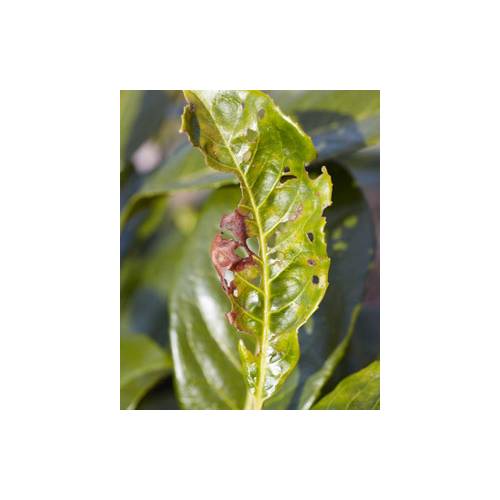
Fungus
Coryneum Blight
- Details
-
This disease is mainly found on plants of the Prunus family, such as plum trees, cherry trees (fruiting or ornamental), The Common Laurel... Although it looks like a disease caused by an insect, it is in reality caused by a fungus called shot hole fungus.
The symptoms
In the spring, the young leaves appear deformed; they sometimes take the form of a sickle. A few weeks later, when they are fully opened, the leaves have numerous small holes, which have irregular margins. The most affected leaves have much smaller surfaces, the holes being rather large and numerous. During summer, the leaves forming seem to be less affected than the spring ones, except in the case of a humid summer.
Lifecycle
This fungus awakens early in the season, from spores (the disease’s germs) which have stayed dormant on the foliage. It is when the weather is humid and when the leaves stay covered with water droplets during a few days that the fungus germinates, on the young leaves tat are developing. Its growth takes effect, detrimental to the vegetal cells that it kills, causing the apparition of small holes caused by the extension of the leaf itself around the small dead area. During this phase, the fungus grows and disperses its germs on to the surrounding areas. When the disease is present, it is a tenacious one. Luckily, Shot Hole disease rarely causes a lot of damage.
How to fight it
Shot Hole disease is fought, by pulverising a product manufactured to fight fungus, such as soluble sulphur or bouillie bordelaise solution. To be efficient, it is necessary to do the treatment before the leaves start to open. Intervene between the end of February (in warmer areas) and the beginning of April (in areas which have late springs), in dry weather, especially if an episode of rain is forecasted for the following days. If your Common Laurels or your purple leafed Prunus are attacked, repeat the treatment towards the end of May, then again in the autumn, towards the end of October. The disease will start to diminish little by little thanks to regular treatments.
How to avoid it
Shot Hole disease finds favourable conditions to its development on trees and shrubs of the Prunus family pruned regularly and particularly in areas where the air is humid (near rivers, at the bottom of valleys…). Always remember to disinfect you pruning tools (secateurs, loppers, hedge cutters, etc.). Clean the blade with methylated spirits before each use and before going on to the next shrub or tree.
Good to know
A rejuvenating pruning carried out in bad conditions can favour the installation of the disease. If a tree has been severely pruned, (large branches being cut off), it forms numerous, untidy new shoots, which constitute a favourable terrain for the Shot Hole disease. - Photos (1)

